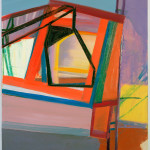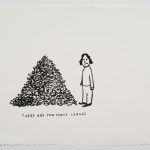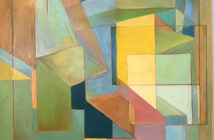It’s hard to believe, but Amy Sillman: one lump or two, opening today at the Institute of Contemporary Art/Boston, is Sillman’s first museum survey show. Comprising over 90 of Sillman’s paintings, drawings, ‘zines and films, one lump or two resists any compartmentalization of her work into period or time. Instead, the show demonstrates Sillman’s engagement with formal and expressionistic concerns as they have persisted over the last twenty-five years, evolving as visual ideations more so than a singular aesthetic. Perhaps Sillman’s resistance to singularity has dissuaded curators from mounting large-scale retrospectives. Whatever the reason, one lump or two doesn’t suffer the pressure of being the first. The exhibition is a confident showing of Sillman’s preoccupations as a painter from the late 1980s until today; it’s also a paean to painting’s endurance into the 21st-century.
 Williamsburg Portraits, 1991-92
Williamsburg Portraits, 1991-92Ink, gouache and pencil on paper
Set of 32: 8 x 11 inches each
Courtesy of the artist and Sikkema Jenkins & Co.
Photo: John Berens
Sillman’s work is rooted in the "triumph of American painting," witnessed mid-century with the height of abstract expressionism, and cultivated in an environment of painterly dissent that characterized the 20th century’s latter half. As curator Helen Molesworth, who organized the exhibition, contends in her essay "Amy Sillman: Look, Touch, Embrace," included in the show’s catalogue, that painting today is understood in terms of failure or ambivalence, affectation and power, and medium-specificity. Sillman’s work courts these contemporary discussions while also challenging ab-ex’s heroic ideals of form and expression. In her paintings, but also in her drawings, cartoons and prints, Sillman courts the reality of relationships via a multiplicity of human emotions.
"Even though her entire oeuvre can be seen as an extended exploration of the formal principles of art, in her work—and its presentation—she takes very seriously the affective possibilities of painting, cuing color to emotion and layering onto the nonverbal realm the visual jokes and humor inherent to cartoons and comics," writes Molesworth. "None of this could be described as remotely heroic; rather, Sillman’s project suggests that neurosis and ambivalence are not childish conditions to be overcome or suppressed, but rather are productive engines for contemporary art."
 Shade, 1997-98
Shade, 1997-98Oil and gouache on wood
50 x 60 inches
Courtesy of the artist and Sikkema Jenkins & Co.
Photo: John Berens
It’s fitting that one lump or two begins with Williamsburg Portraits (1991-92), a grid of 32 drawings modestly pinned to the gallery wall at the exhibition’s entrance. Each is uniformly small and captures a person in Sillman’s orbit in the early 1990s Brooklyn art scene. Williamsburg Portraits is self-conscious and jocular. The work reveals Sillman’s cartoonish figuration, which matures in her later work. It also betrays how vital community is to creativity. While the 1950s New York School had Downtown, Sillman and her community had Williamsburg.
The exhibition’s first room also includes Shade (1997-98), which further explores human connectivity as well as abstraction’s parameters. This large oil and gouache painting depicts three pairs of humanoid figures—one pair is tethered while one is not, the third simply white, ghost-like.The figures are placed on a dark blue strip of horizon, while a pale pink, the color of a summer sunset, dominates the top of the picture. Here Sillman is preoccupied with her palette’s power to evoke mood. The painting also demonstrates Sillman’s interest in landscape painting and exploitation of the horizon line as a formal and affective tool. The horizon is an orienting device contingent on our movements. That these three pairs, all of which are experiencing some level of separation, are resting upon the horizon, thus susceptible to its flux, underscores Sillman’s abiding concentration on interdependence.
 Me & Ugly Mountain, 2003
Me & Ugly Mountain, 2003Oil on canvas
60 x 72 inches
Collection of Jerome and Ellen Stern
Photo: John Berens
"Amy doesn’t believe in any version of either/or," said Molesworth at a press preview earlier this week. "The operative word for Amy is ‘and'." Sillman’s works express a duality, or more precisely, a "parathaxis," which Molesworth defines in her essay as "two things simultaneously." This dualism isn’t a neat dichotomy or polarity; in fact, it’s a refusal of both. Sillman’s works insist on being inclusionary, while simultaneously acknowledging that one can never entirely know everything. Me & Ugly Mountain (2003) expresses this idea while exhibiting Sillman’s bright color palette and interest in landscape painting. A morose, cartoonish figure grips a rope attached to a sack of abstract, indistinct forms. This connecting cable has evolved from the umbilical cord in Shade to a taught thread joining joins the figure to what he drags with him. The enormity of the sack and its contents and the figure’s smallness signify life’s emotional baggage. This also achieves a plasticity of form without condensing the picture into total abstraction. Sillman’s not playing with the figure in abstract painting, she’s probing figuration and abstraction equally.
This culminates with a grouping of paintings and drawings in one of the exhibition’s final galleries. In 2006 and 2007, Sillman began drawing couples in love in situ. She would then go home and draw them again from memory, and finally, using the point where the couple physically connected, Sillman would paint an abstraction of that connection. This process mimics how romantic relationships mature into couplings, and the abstract paintings become a record of connection at an elemental level. The intimate and immediate gesticulations of Sillman’s drawings are translated into her painting’s vivacious conflux of material, color and form.
 N & O v3, 2006
N & O v3, 2006Ink, colored pencil and gouache on paper
17 x 14 inches
Courtesy of the artist and Sikkema Jenkins & Co.
Photo: John Berens
While responsiveness is overt in these drawings and paintings, reaction (or the interrogation thereof) is fundamental to Sillman’s works, especially in her humorous cartoons and charts. Sillman observes and remarks on connection and emotion using a simplified visual language of line drawing or color. Anxiety and awkwardness dominate, both palatably conveyed through grace of form and exuberance of color. In the exhibition’s last gallery, the emotions of human association and painterly abstraction coalesce in large-scale paintings, delicate ink drawings, as well as iPhone-initiated drawings and videos. The large paintings are rooted in Sillman’s examination of the diagram as a visual and communicative device, while the iPhone works respond to the growing use of the telephone as a technology for everything and the ink drawings speak to the frequent failure of communication. The paintings are ambitious, bearing the mantle of ab-ex well. But unlike the paintings comprising MoMA’s 2010 Abstract Expressionist New York, these works don’t assume supremacy over anything else. In one lump or two, nothing is taken for granted because everything is something.
- Williamsburg Portraits, 1991-92 Ink, gouache and pencil on paper Set of 32: 8 x 11 inches each Courtesy of the artist and Sikkema Jenkins & Co. Photo: John Berens
- Shade, 1997-98 Oil and gouache on wood 50 x 60 inches Courtesy of the artist and Sikkema Jenkins & Co. Photo: John Berens
- Me & Ugly Mountain, 2003 Oil on canvas 60 x 72 inches Collection of Jerome and Ellen Stern Photo: John Berens
- N & O v3, 2006 Ink, colored pencil and gouache on paper 17 x 14 inches Courtesy of the artist and Sikkema Jenkins & Co. Photo: John Berens
- C, 2007 Oil on canvas 45 x 39 inches Collection of Gary and Deborah Lucidon Photo: John Berens
- Untitled Cartoon from Amy Sillman: Visiting Artist, 2002 Ink and gouache on paper 9 1/2 x 9 3/4 inches Courtesy of the artist and Sikkema Jenkins & Co. Photo: John Berens
- #841 (painting from print from animated drawing), 2012 Oil on canvas 51 x 49 inches Courtesy of the artist and Sikkema Jenkins & Co. Photo: John Berens











